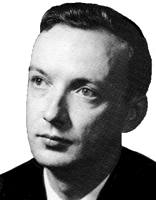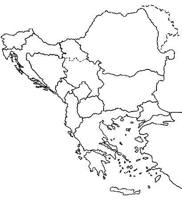
|
The Society of Folk Dance Historians (SFDH)
Kolo: Some Background
Home |
About |
Encyclopedia | CLICK AN IMAGE TO ENLARGE |

|
In order to discuss the kolo situation in the United States today, we have to go back to the turn of the century and examine the dance background in Yugoslavia itself at the time when immigrants from that area began coming to our country. It's difficult to get a good detailed picture of that period, because it wasn't until 1934, through the pioneering efforts of the sisters Ljubica and Danica Janković, that any systematic attempt was made in Yugoslavia itself to collect, preserve, and document its immense folk dance wealth. However, we can piece together a sufficiently accurate picture to draw some general conclusions about Yugoslav dancing half a century ago. For our purposes, it's convenient to divide the subject into two aspects: "city" dancing and "village" dancing.
A long struggle to liberate themselves from the Turks had built up within the Serbs an intense nationalism which appeared in their literature, music, and other facets of their culture. The way in which this national pride evidenced itself in the city dances is particularly interesting. City dancing masters began looking toward the folk dances for inspiration, and started composing ballroom dances in the native idiom. Along with the French quadrilles and other dances in vogue at urban balls, there began to appear kolo dances done in circles and lines, patterned after the Kolos done in the villages. In many cases the dancing masters borrowed melodies and steps directly form the village dances, but these were usually a bit too brusque or crude, so they composed melodies and manufactured steps and figures, in an attempt to combine the folk element with the courtly style that was fashionable at the time.
These various composed kolos served the same purpose as did Korobushka in Russia or Beseda in Czechoslovakia. They were dances "in the manner" of native folk dances but were intended for performance in the ballroom. Kolos of this kind numbered in the hundreds, and they came and went in popularity. They were taught in all the fashionable dancing schools and spread throughout Yugoslavia.
Some were composed in honor of noble families or individuals, that is, Jeftanovičevo, Kurtovica, Kraljevo oro, Nataljino; others were dedicated to political parties: Radikalka, Liberalno kolo; still others were given patriotic names: Srpkinja, Srbijanka; a number were named for different sections of the city of Belgrade: Čukaričko Kokonješte, Savamalsko kolo, Dorčolka; certain professionals had kolos dedicated to them: Officirsco kolo, Profesorka. Among the other ballroom kolos familiar to us in America are Seljančica, Sarajevka, Vranjanka, Kokonkješte, Žikino, Rumunsko, and many others.
The fact that these ballroom kolos were widespread throughout Yugoslavia fifty years ago as of 1954 accounts for their being brought over to America by the immigrants at that time. A count of the kolos now done in the United States will show that about 80 percent are of the old ballroom type. About the only "folk" Kolos brought over were Malo, Veliko, Erdeljanka, Milica, and Drmeš.
VILLAGE DANCING
To better understand why more village Kolos were not brought over, we need only consider that any particular village dance is usually restricted to that village or its vicinity. Hence, it would have been difficult for people from different parts of Yugoslavia to get together and do each other's dances. It was much easier to dance the more universal ballroom Kolos which almost everyone knew.
Of the few folk kolos that survived in the United States, Malo, Veliko, Erdeljanka, and Milica were from the province of Vojvodina, where the best tamburitza players come from, and it's probably through the tamburitza players that the melodies and steps for these kolos became popular, after the immigrants were already in America. There is no other logical explanation for the fact that Croatians in this country, most of whom come from around Zagreb and Karlovac, are dancing kolos typical of Vojvodina, far to the east.
The overwhelming majority of Yugoslav immigrants came from the northern areas of the country (Croatia, Slovenia, and Vojvodina), and, of course, brought with them cultural traits from those areas only (the tamburitza "basic step," for instance). However, the music and the dances of the rest of Yugoslavia never reached our shores.
In other words, America received only a small, quite restricted sample of Yugoslav music and dance, consisting of about twenty ballroom Kolos, four or five typical dances of Vojvodina, and the music of the tamburitza instruments, which, while rich and beautiful, is only a fractional part of the real wealth of Yugoslavian music.
It is a well-known fact that when people migrate from one area to another, the culture they carry with them retains certain elements from the original environment, but inevitably absorbs characteristics of the new surroundings. Most of the Kolos brought to America eventually died out in Yugoslavia itself, while they lived on in this country among the second and third generation Croatians and Serbs. However, many changes took place in these dances, so that today when one observes them at Croatian and Serbian affairs, they are quite different from what the originally were.
DANCES CHANGE
Yugoslav-Americans were tired of doing the kolos the same way year after year – women began dancing "basic step" with variations that looked tricky in high heels; men improvised freer, broader figures similar to those of the jitterbug; and many steps were introduced, such as triple stamps in the middle of Seljančica, individual turns and claps in Zaplet, and complex scissor variations in Žikino.
American-born tamburitza players became interested in other types of music found among the nationality groups in the American. For example, tamburitza orchestras in America< have a great love for Russian and Ukrainian music, because it is adaptable to the tamburitza instrument. Tamburaši may strike up Hopak during an intermission, someone makes up a kolo with crouches to go with the music, calls it Kozačko kolo, and a new dance is on its way to becoming a standard favorite among the Serb and Croatian settlements throughout the country. American Yugoslavs have taken the Mexican La Raspa and created King kolo, and recently they borrowed the Greek Syrto Samiotissa, dubbed it Makedonka, and even composed Serbian lyrics to go with it.
Dance leaders have appeared among the Croatian and Serbian< colonies, and are trying hard to spread kolo among their own people. These leaders, often with great imagination, head kolo clubs in various cities, but unfortunately there is a lack of uniformity in the way they teach, so that Chicago kolo dancers are often unable to dance with those in Pittsburgh, who in turn differ from those further east. A "Kolo Federation" was organized in the east, but a feeling of competition developed within it, prompting leaders to compose new kolos, to add many figures to originally simple dances, and to attempt in other ways to outdo each other. Besides creating a confused situation for folk dancers who go to the "halls" to dance kolo authentically with the people, this sad element of competition greatly jeopardized the success of what began as a healthy movement toward the preservation of Yugoslav dance in America.
THE FUTURE?
There are very bright spots in the kolo picture, however, which off-set some of the negative elements. First, there are a number of Croatian< and Serbian colonies in the United States where the dances have been remarkably well preserved, notably New York and several smaller settlements in Pennsylvania. Secondly, the Duquesne University Tamburitzans, a Yugoslavian music and dance group located in Pittsburgh, have made several trips to Yugoslavia< itself to collect dances and music hitherto unknown in America, material which is being presented in concerts to the American public. Thirdly, the recent popularity of kolos among non-Yugoslav folk dancers has stirred up a great deal of interest in kolo background, to the extent where there are probably more non-Yugoslavs now dancing kolos than Yugoslavs themselves.
DOCUMENTS
- Croatia, a country.
- Dick Crum, an article.
- Igra Kolo: Dance Kolos with John Filcich, a book.
- Ljubica and Danica Janković, an article.
- Serbia, a country.
- Sing and Dance the Kolo, a book.
- Vranjanka, a book.
- Yugoslavia, a former country.
Reprinted from "Some Background on the Kolo in the United States" by Dick Crum
in Viltis Magazine, October-November 1954, Volume XII, V. F. Beliajus, Editor.
This page © 2018 by Ron Houston.
Please do not copy any part of this page without including this copyright notice.
Please do not copy small portions out of context.
Please do not copy large portions without permission from Ron Houston.
